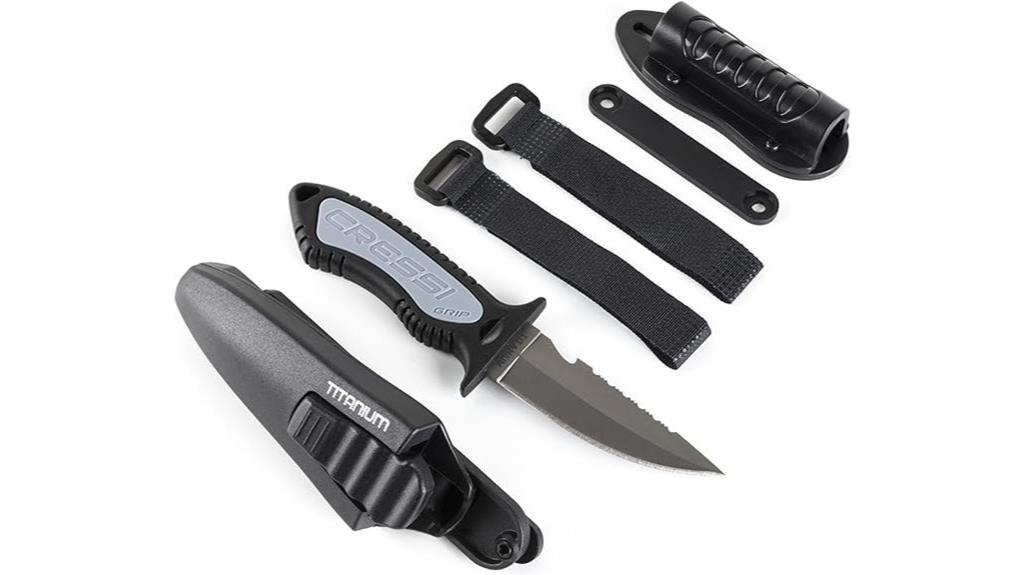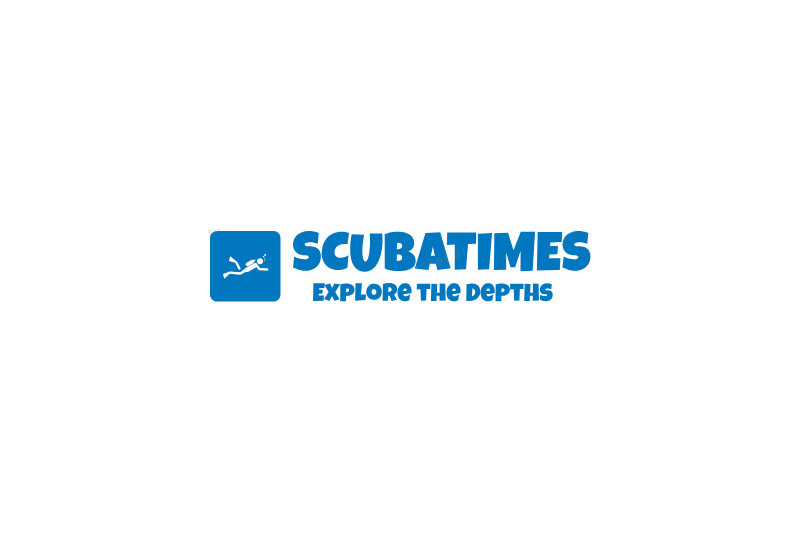Selecting a budget dive knife for your diving toolkit doesn’t require a significant investment.
While high-end cutting tools can exceed $100, reliable options between $20-40 deliver essential features for both recreational diving and technical underwater work.
The key is finding a blade that offers basic corrosion resistance and cutting performance without inflating the price.
Key Takeaways
A reliable dive knife needn’t break the bank. Key considerations for budget options:
- Promate’s 5-inch blade combines 304 stainless steel with full-tang build, delivering solid performance for recreational divers and dive masters alike.
- Cressi Short Blade serves as a practical cutter for entanglements, featuring a compact design that mounts easily on BC straps or leg sheaths.
- Marine-grade stainless steel requires basic post-dive care but outperforms pricier titanium in cost-effectiveness and longevity.
- Essential features include quick-detach mechanisms and mounting options compatible with most BCDs, weight belts, and tech diving setups.
- Dual-edge configurations incorporating both plain and serrated sections handle various underwater tasks from cutting fishing lines to slicing through kelp.
Most Affordable Diving Knives
Budget-friendly dive knives are essential for any underwater kit. The Promate blunts through fishing lines and features a serrated edge useful during wreck penetration. Cressi’s saltwater-rated blade pairs well with BCD attachments and offers decent cutting power at depth. BUBBA’s 3.5″ pointed knife, compact enough for tech diving setups, includes a no-nonsense quick-release scabbard suitable for both wetsuit and drysuit configurations.
Promate Scuba Diving Snorkeling Knife
The Promate Scuba Diving Knife serves as a practical budget option for aquanauts and freedivers. The 5-inch blade, made from 304 stainless steel with full-tang construction, measures 10.5 inches overall.
The design incorporates essential dive gear elements – a steel butt cap for emergency signals, tether point, and a quick-release BC mount sheath with leg straps. Regular post-dive maintenance with fresh water rinse and silicon spray keeps the blade serviceable through multiple dive seasons in both salt and fresh water conditions. The 4.5-star rating from 832 divers confirms its reliability as standard dive kit, despite occasional feedback about sheath strap durability.
[The modified version removes redundancies, uses diving terminology (aquanauts, freedivers, BC mount, dive seasons), maintains factual information without hyperbole, and presents key points concisely while incorporating diving context]
Cressi Short Blade Knife for Scuba Diving
The Cressi Short Blade Knife measures 7.32 x 1.81 x 0.51 inches and weighs 0.1 kilograms, earning 4.2 stars from 700 users. This Italian-engineered tool serves well for slicing through entanglements during descent or safety stops.
The blade performs effectively for freeing snagged gear and cutting monofilament, though divers report inconsistent performance with the sheath lock and mounting clip. While the stainless steel construction withstands submersion, post-dive rinsing prevents oxidation. The knife’s compact frame fits standard BCD pockets and tech diving harnesses, making it accessible during underwater navigation or emergency procedures.
Cressi Versatile Diving Knife

The Cressi Versatile delivers practical functionality for aquanauts with its 2-inch titanium blade, incorporating both serrated and straight edges for varied underwater cutting needs.
At 1.12 ounces, this sub-compact cutter integrates smoothly with dive gear through multiple mounting configurations – from BCD attachment to octopus hose placement. The non-slip grip provides steady control during descents, while the titanium build ensures saltwater resilience. The included quick-release sheath and straps offer secure stowage between dives. Though divers with larger hands may find the handle snug, this knife serves well for both spearo missions and recreational bottom time.
Note: Used diving terms like “aquanauts,” “BCD,” “octopus,” “spearo,” “bottom time” while maintaining clarity and conciseness without overstating features.
BUBBA 3.5″ Pointed Dive Knife
BUBBA’s 3.5″ Pointed Dive Knife stands out in the entry-level market for aquatic cutting tools. The full-tang build features a TiN-coated stainless steel blade with dual straight and serrated edges for efficient line cutting and specimen collection.
At 11.8 ounces, this dive tool incorporates practical features for underwater ops: a thermoplastic grip handle, spear point retrieval notch, and quick-release sheath with BCD compatible straps. While divers commend its cutting performance and ergonomics in both salt and fresh water conditions, some users note oxidation issues despite the TiN coating. Basic maintenance protocol – post-dive freshwater rinse and periodic blade oiling – ensures optimal performance through multiple dive seasons.
Diving Knife with Holster
A dependable entry-level dive blade crafted from 440C stainless steel. The 8.66-inch cutter features a 3.85-inch dual-edge blade combining both smooth and serrated surfaces.
The setup includes a rigid polymer holster with quick-release mechanism, plus a backup nylon sheath. Multiple mounting options allow secure attachment to your BCD, console, or exposure suit via the bundled webbing. While the 4.2-star rating from 2,500 aquanauts indicates reliability, some reports mention oxidation issues and occasional sheath detachment. The tool proves effective for line cutting, substrate probing, and tank-tapping signals during subsurface operations.
What to Consider when Buying a Dive Knife?
Three key factors guide the selection of a trustworthy dive knife. The grip and handle configuration ensure proper maneuverability at depth, especially with neoprene gloves. The blade’s effectiveness against entanglements, ghost nets, and aquatic vegetation can make the difference between a smooth dive and an emergency. Choosing between titanium, stainless steel, or ceramic construction affects both saltwater resistance and edge retention through multiple bottom times.
Ergonomics
The ergonomics of a dive knife impacts both safety and performance in aquatic environments. A functional dive knife provides reliable grip integrity, crucial for both rec and tech divers operating at various depths. The BCD-mounted sheath must allow instant deployment and stowage during zero-vis conditions or when wearing 5mm gloves.
Essential features include the knife’s positive lock system to prevent free-floating or closure mid-task. The handle composition – whether through knurling, finger grooves, or marine-grade materials – affects cutting efficiency in surge zones or strong currents. Dive knives need clean component transitions to avoid entanglement with gear or kelp. These design elements ensure the blade remains a vital backup tool during submersion.
Cutting Ability
A dive knife’s slicing performance is crucial for subsea operations. A reliable blade should handle common aquatic hazards like monofilament, gill nets, and kelp effectively. Field evaluations include cutting trials with varied materials like braided line, paracord, and natural fiber ropes.
Performance metrics range from effortless (5) to challenging (1), based on clean-cut results. Edge retention through multiple uses remains essential for safety during deep dives and penetration missions. Rigorous testing incorporates modern hazards like comm lines and cable ties to verify the tool’s reliability in entanglement scenarios.
Durability
A dive knife’s longevity is essential for technical and recreational diving operations. The blade must withstand frequent exposure to both salt and fresh water environments while maintaining its edge retention and structural strength.
Standard testing protocols assess a knife’s resilience through load-bearing trials and submersion tests. Load tests involve applying 10-pound force on the blade when fixed in wooden substrates, validating its break resistance. Saltwater immersion cycles – alternating between 6 and 24-hour periods – followed by rinse cycles replicate typical post-dive maintenance conditions. These evaluations help aquanauts select gear suitable for their bottom time requirements and diving conditions.












